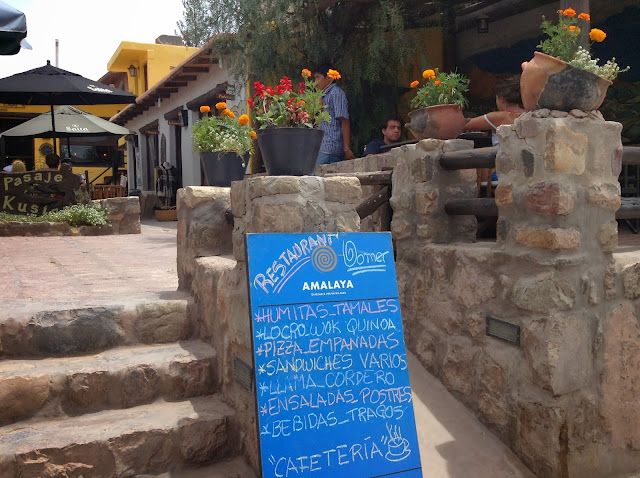Our last meal at "La Cabrera" located in Palermo near our hotel. The meat is served with "sides" that make the meal so flavorful and interesting i.e. creamed spinach, puréed squash, pickled onions, creamed horseradish, pureed beets, a cucumber sauce, chimichurri, lentils, olive tapenade etc...
Monday, January 27, 2014
Sunday, January 26, 2014
Our day trip to San Antonio de Areco
Parroquia San Antonio de Padua........church built in 1730
People praying
Fishing for perch. I decided to avoid having river fish for lunch
Estancia built in 1717
Gaucho museumThe gaucho museum has a fine collection of sculpture, art, furniture, horse tack and ropes, lassos, saddles, boots, belts, cinches, guns and knives used in ranching.
The gauchos had neither TV nor radio. They spent evenings drinking, telling stories and gambling. One of their games, the first pinball machine, was to toss a coin into the mouth of the frog. It is hard to do.
The Ombu trees can grow for 300 years and are good shade providers. They were brought here by the early settlers as there were few native shade trees and every estancia needed shade in the hot summer. Last week it was over 110 degrees, an all time high.
Our return to Buenos Aires
We are happy with our suite at the Aspen Hotel in Palermo Soho, Buenos Aires. Pictured is our sitting area and small kitchen and king bedroom through the door. Cost to us in dollars.....$135 per night. sweeeet for the suite!
This two year hotel is not fancy but is more than adequate. The rooftop pool is a nice respite after a day in the city. We also love the neighborhood. It will be nice when they finish the storefront remodel.
Across the street from the Aspen hotel is our new favorite restaurant "Las pizarras Bistro"(laspizarrasbistro@gmail.com) Do not even try to try to come here without a reservation. We have dined here twice while in BA and saw them turn away many potential diners. Every table full both nights.
My Risotto de calabaza y langostinos y ralladura de limon (Shrimp, pumpkin & prawn risotto) was memorable. Note to self: try to make at home!
Dale had calamari steaks that were delicious but especially loved his dessert: Cerezas son curd de limon merengue y helado de coco (cherries with lime curd, bits of crumbled meringue with coconut ice cream. )
Friday, January 24, 2014
Our return to Salta
Salta la Linda (the beautiful) Here is the statue of General Arenales, a hero of the revolution of 1816, in the central plaza 9 de Julio.
The basilica (cathedral) San Francisco in the main central plaza.
Dale enjoyed talking with the shoe shine boys. He tipped them well and they were so happy. I got the first shoe shine in my life but who could say no to these hard working young men.
The San Bernardo convent, nearly 400 years old, is the oldest building in Salta.
A ride in the teleferico can be very hot in the afternoon but the views from the top of San Bernardo Hill overlooking Salta are wonderful.
A sole and pasta lunch on calle (street) Balcarce near the main square.
The wonderful MAMM museum the home of the three children who were buried alive as an offering over 500 years ago and discovered in nearly perfect condition in 1999. Wednesday, January 22, 2014
Northern circuit part two: Purmamarca to Humahuaca through the Quebrada de Humahuaca
Webster describes a quebrada as "a ravine that is normally dry but is filled by a torrent during a rain" but our driver today insists it is much grander and so much more. We agree....it is a 124 miles long network of valleys with multicolored slopes that rise up on both sides that seem endless!
Humahuarca - a UNESCO World Heritage Site in the Quebrada
The street asado smelled sooo good, but we chose instead to seek out the restaurant with the fabulous empanadas our driver suggested we try for lunch in the quaint town of Tilcara.
In the outskirts of Tilcara an ancient fort or "Pucara" was discovered in 1909 by archeologists. This 40 acre village was occupied 1,000 BC (before Christ) until the 16th century. In other words.....these ancient inhabitants lived here in the Andes long before the Spaniards arrived. Gail checks out one of the rebuilt houses.....so very small.
Tropic of Capricorn
The landscape changes dramatically as you leave the Quebrada in Jujuy province and return to Salta province on route 9. Here we saw random groups of both cows and goats blocking the road. There were road signs warning drivers to "watch for cows!"
Tuesday, January 21, 2014
Subscribe to:
Comments (Atom)


















































